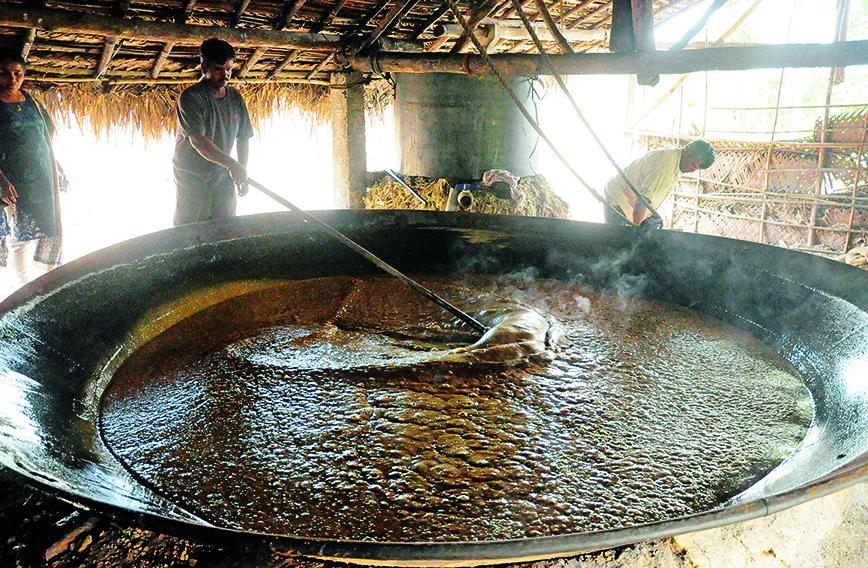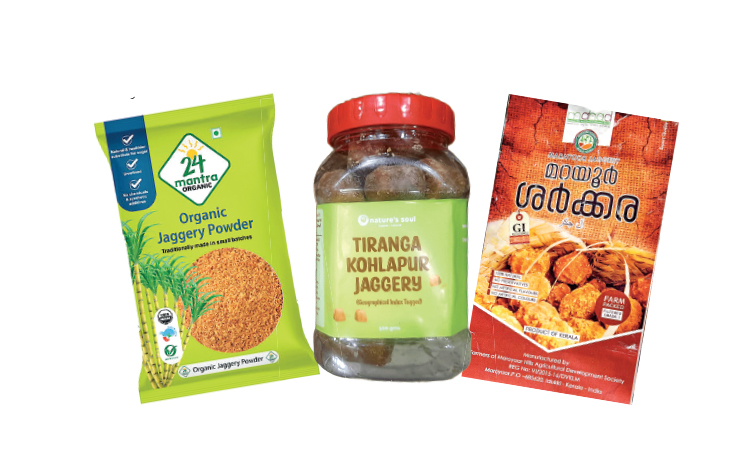
Marayoor jaggery being made the traditional way in the Idukki district of Kerala
Good jaggery: When searching remember dark is better
Sukanya Sharma
All talk about white sugar begins and ends with getting off it. But gur or jaggery, no less sweet and laden with calories than white sugar, has got a formidable reputation for being wholesome.
Traditionally used in Indian households in desserts or just to nibble on after a meal, gur now also has a growing fan following among the health conscious. It has something to do with the times. People are more careful about what they eat.
Gur comes from the sap of palm trees and sugar cane. It is nutrient rich. It is full of minerals. If you happen to be short on iron, gur is for you. Lore has it that it works as a digestive after meals.
So, if you are looking to sweeten that mid-morning coffee, powdered gur is what you want. Gur has also gotten to be trendy. When you serve it you are among the woke people who not only know that gur, lumpy and organic, is good but also better than anything else — processed, refined or artificial.
Recipes for which gur is employed exist in every family and could fill a book. But how does one ensure that gur, commercially packed and sold as jaggery, one is getting is pure? With so much commercialization happening, a wholesome natural product hasn’t been spared. How good it is will depend on who is making it. Many bulk manufacturers use chemicals to instil colour and enhance shelf life. So, how do you choose?
“The dark brown colour, which is the natural colour of jaggery, is good for health,” says Dr C.R. Elsy, retired professor of Kerala Agricultural University, who has been supporting traditional producers and spreading awareness about the value of organic jaggery and the dangers of chemical additives.
Despite all the talk of organic jaggery, commercial jaggery made with chemicals still has a wide consumer base. The main reason is that people prefer to see their gur in a particular colour.
“Some prefer golden-brown, some yellow and others orange. Depending on their preference, manufacturers are forced to add chemicals to get that colour. Very often even chemicals actually used to tan leather are used,” says Dr Elsy.
These chemicals linger in the jaggery, disrupting its purity. They have a detrimental effect on health. Organic jaggery, with richer flavour and higher nutritional value, is the preferred choice for those seeking healthier and environmentally sustainable alternatives.
Take, for example, Marayoor jaggery made in the Idukki district of Kerala. “While making Marayoor jaggery, not a single chemical is added. But vendors selling payasam tell us that if they made this sweet with Marayoor jaggery, it will not sell because the colour becomes too dark,” says Dr Elsy.
“Lime or okra juice is used during the clarification process. Both help remove dust and impurities. Since we do not add preservatives, Marayoor jaggery must be stored in the refrigerator.”
Dr Elsy advises consumers not to buy jaggery that has chemicals. “And look out for preservatives too,” she cautions.
Prioritising purity makes it easier to enjoy the health benefits jaggery offers. You can savour its natural sweetness without guilt.
“Varieties that are dark brownish usually contain higher levels of minerals like iron and calcium. Avoid jaggery that appears pale, as that indicates it has undergone excessive processing,” says V.K. Dixit, an experienced professional in the sugar industry and president of Oswal Overseas Ltd in Uttar Pradesh.
The organic shelf
There are a few names in the jaggery business that are reputed for their commitment to quality and traditional production practices. They also help farmers sell their produce in bigger cities. We are talking here of 24 Mantra, Nature’s Soul, Organic Tattva, Nutri Org and Miltop.
Founded two decades ago by Raj Seelam, 24 Mantra is renowned for its organic jaggery. A half-kg pack of unbleached jaggery powder is for Rs 80 and is available in supermarkets and online platforms such as Amazon, Big Basket and Blinkit.
“As someone who needs to cut refined sugar from my diet, I always opt for 24 Mantra’s organic jaggery as my go-to sweetener,” says Dhruv Tiwari, creative director at DDB Mudra Group.
Ordering last-minute on apps like Blinkit makes it more accessible and aligns with his late hours. One of the special features of 24 Mantra’s jaggery is its purity and authenticity. Traditional methods of pressing and distilling palm are still being used.
This involves three key steps — extraction (of juice from sugarcane), clarification (filtering of inorganic salt, fibre, wax, etc.) and concentration (boiling the juice for hours). This process ensures high quality and nutritional value, making 24 Mantra a trusted player in the market.
Nature’s Soul in South Delhi sells premium organic jaggery. They have tied up with farmers in various districts, like in Kolhapur district of Maharashtra.
“The sugarcane that grows along the Panchganga river here is mature and GI tagged. The farmers we have tied up with are fourth-generation gur farmers. Since they are busy throughout the year, they find it tough to brand themselves and, therefore, selling is a problem for them. That’s where we come in. We source from them and then market their jaggery across the country. This is the story of Tiranga jaggery from Kolhapur,” says Arjun Sahni, founder of Nature’s Soul, talking about their best-selling jaggery.
Another popular product is the digestive spiced and mixed nuts jaggery, produced by farmers in Sirmour, Himachal Pradesh.
Nature’s Soul also sells jaggery products marketed by brands like Mother Organic from Uttarakhand, Pro Nature, which produces jaggery in Haridwar, and Adya Organics, producers of date palm jaggery powder, based in Patna.
Adya Organics, producers of date palm jaggery powder, based in Patna.
These are available in select health food stores, their Nature's Soul outlet in New Delhi’s Defence Colony and from their website. Prices range roughly from Rs 95 to Rs 399 for a half-kg pack.
“I can vouch for the exquisite taste of their Tiranga jaggery. My grandfather adores it. Each time he craves something sweet, he asks for Tiranga gur. It has become a staple dessert in our home,” says Akanksha Mediratta, senior accounts manager at Google and a regular at Nature’s Soul. Although she is based in Dublin, this store is a stop she doesn’t miss on her trips to Delhi, twice a year.
Founded by Rohit Mehrotra, Organic Tattva is based in Greater Noida and offers a diverse range of organic jaggery products in cube and powder form. Their bestseller is jaggery powder which is priced at Rs 81 for 500 gm. It can be found in organic stores across the NCR (National Capital Region) and on their website.
A unique feature of Organic Tattva’s jaggery is its fine texture and distinct sweetness, making it ideal for a variety of dishes. “I use it for kheer, teacakes and in plain milk too,” says Tanuja Krishnatray, former principal, Little Footprints Preschool.
Nutri Org specializes in high-quality jaggery that is sourced from farms in the Uttarakhand belt. The company sources from 400 to 500 farmers who cultivate organic sugarcane for Nutri Org. “I would suggest that our jaggery be used as a replacement for sugar or any other sweetener in milk and tea. It should be added after boiling, instead of before, for best results,” he says.
Miltop’s organic jaggery products are known for their earthy flavours. Their jaggery is available in organic stores and several online platforms. The brand is committed to ethical sourcing and environmental sustainability and claims to have greatly reduced the use of plastic in their packaging too.
“Miltop jaggery powder is of high quality, with a rich colour and good texture. My daughter loves it,” says lawyer Seerat Randhawa, who has a start-up venture of her own. She has made a conscious choice to introduce her eight-year-old daughter to jaggery as a replacement for refined sugar.
In moderation
Packed with essential minerals like iron, calcium, magnesium, and potassium, jaggery has its share of health benefits. It can assist bone health, prevent anaemia, and help regulate blood pressure. Its high iron content makes it useful for patients with iron deficiency. Jaggery is also known to regulate body temperature and keep you warm in the colder months of the year.
“Jaggery helps to boost immunity and regulate hormones, especially endorphins, in women. It also helps to reduce stress,” says Shally Khurana, dietician at the AIIMS Trauma Centre.
However, jaggery is not recommended for diabetic patients due to its high glycaemic index, she says. “While it is beneficial, jaggery should be consumed in moderate amounts and never in excess because it carries a risk of sugar spike,” she explains.
Even in the medical fraternity, there are different perspectives on jaggery. Dr Namrata Singh, former dietician at AIIMS and professor of Nutritional Sciences at the Indira Gandhi National Open University (IGNOU), has a more cautious view.
“The calorific value of sugar and jaggery is the same. But since jaggery is not as refined as sugar, it contains useful micronutrients and some iron. This is its main advantage. However, since these micronutrients are present in minimal amounts, one would have to consume a substantial quantity of jaggery to benefit from them — which is not advisable because that would lead to soaring your calorie intake,” she says.
“When it comes to research regarding nutrition, there are a few review papers published by pharmacologists and agricultural scientists but none from a nutritionist’s point of view,” says Dr Singh.
Moderation is the key, she says. “It is better to use it as medicine. For instance, in homemade ointments and as the classic remedy for a sore throat by combining ginger and honey with jaggery."
Dr Singh advises consuming jaggery in small quantities. “In a 2,000-kilo calorie diet, the allowance for sugar is 20 to 25 gm a day. So, I would say the same amount is recommended for jaggery on a daily basis, if it is being used as a replacement for sugar. More than that would be harmful,” she warns.
Comments
Currently there are no Comments. Be first to write a comment!



